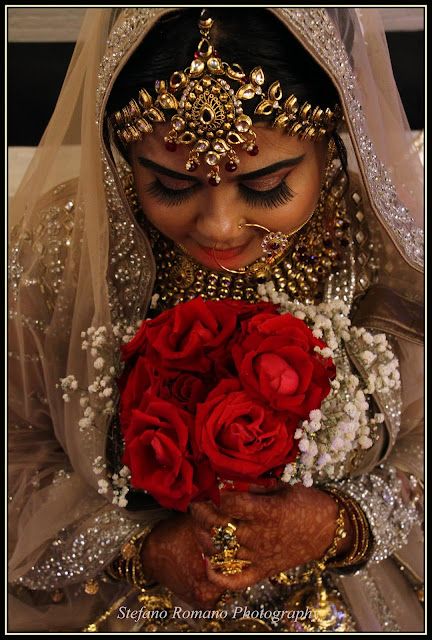 |
| “Wedding Reception”. Centocelle ROME – 20 September 2020 |
We arrived at the wedding reception, the most gorgeous day in terms of economic spending and clothing.
We have seen how in marriages the consent of families is fundamental, especially of the elderly, only then can the consent be formalized with the ceremony called “Dehka-dekhi” which sounds like “let's see!” It is a very important moment, in which the two families of the spouses meet in one of the two houses, often in the presence of the imam, and if the offer of the dowry is considered valid, the documents are signed and the wedding day is decided.
Only then
is the tension dissolved and the family can celebrate with sweets and Paan-Chini,
or betel leaves and araca nuts.
The
reception is usually organized by the bride's family and the groom, with his
retinue of family and friends (Borjatri), arrives late in the evening.
Before reaching the wedding venue, the groom asks his mother for permission to
start a new life, and usually it’s the mother who accompanies him.
The
reception, in the country of origin, is called “Preetibhoj” and is
usually done outdoors, to introduce the bride to society.
It must be said that it's really difficult to orient oneself in this maze of rituals and names, in three days, bouncing from India to Bangladesh and between Hinduism and Islam; and often incorrect information is also found on major news sites. The example of Bou Bhaat is worthy of note, which is often written as Bou Bath, suggesting the “wife's bath” (bou in Bangla is wife), while the correct diction is Bou Bhaat, or “wife's rice”.
This very
important rite has some differences in the two versions of Hindu-Muslim weddings: essentially, it's the rice
that the wife cooks, for the first time, for the groom and his family, at home,
after marriage.
In Hindu
marriage Bou Bhaat takes place on the third day, during the day, when the wife
cooks rice for her husband's family, and he gives her a saree and a plate of
food asking her to take care of him for all life - “Bhaat Kapor”.
Hindu
marriage is not that different from the Islamic one, except for the religious
part, of course. But a big difference is that, although it is also celebrated
in three days, all the main rites take place in a single day: the first, with
the Gaye Holud in the day and the wedding in the evening.
On the
second day, Basi Beeye is celebrated and the wife leaves her home to live in
her husband's family home. There are also funny legends on the wedding night,
like that of the Phool Shojja, which is the “bed adorned with flowers”.
It is said that on their wedding night the newlyweds cannot have sexual
relations (“Kaal Ratri”), so in their room there are the friends of the
groom, even under his bed, to keep watch with him over the presence of the
demons that would make their unfortunate and cursed married life – but this
seems to be a joke to entertain young people.
The third
day is Bou Bhaat and in the evening, finally the reception.
One of the
most exciting rituals in particular, after marriage, is the Bidaay, or
the moment of joy and sadness in which the bride says goodbye to her family.
The bride must throw rice into her mother's saree to compensate for the responsibility
the mother has had for her and which, from now on, will be borne by her
husband.
This is, in
short, the wedding and now I leave you with some photographs of Nadia and Sayeem's wedding reception.
One last thing, basically the color of the bride's dress is red, linked to the new birth, as well as for the New Year's celebration (Poela Boishakh), but now other trends are followed and it is no longer a certainty.
In the next
- and last - article we will look at the Islamic Nikah in another wedding.
 |
 |
 |
| Centocelle. ROME – 20 September 2020 |














All photos are really stunning and the 1st one is my favourite.
ReplyDeleteReading this, I'm notice that culture are stay n what make difference are religion and belief...
*faith
DeleteHappy you like it 😀
DeleteLove reading this article.
ReplyDeleteI read a new knowledge. It refreshed my mind from the normal routine of life.
The beautiful photos also make me want to be like a bride too.😊
Can't wait to read about the next wedding.
Really thanks 😊😊
DeleteVery interesting...good to know other people's culture.
ReplyDeleteSome of them are very similar to the culture in my place.
This is the beauty of the influence of colonialism and the spread of religion through culture.
Yes that's true, but not so agree about beauty of colonialism, usually they not did so good 😉😊
DeleteI mean the colonialism of religion...should read my comment deeply yaa Tuan😉😊
DeleteOk sorry Puan 😅
DeleteO.K.✌😎
DeleteTrue to form, the bride looks at her best during her wedding day.. Goes with the groom too. Best wishes to them🌹🌹🌹.
ReplyDeleteYour photos look so alive. You are the best.
Deeply thanks 🙏
DeleteAn interesting article.
ReplyDeleteTerima kasih ☺️
DeleteThis blog beautifully captures the essence of Nadia and Sayeem's Bengali wedding. For those planning a wedding, finding the perfect venue is crucial. If you're looking for a memorable experience, consider a wedding venue Chennai. Its charm and variety can make your special day as enchanting as this Bengali celebration.
ReplyDeleteThis blog beautifully captures the essence of an intimate wedding. For couples seeking similar cozy and memorable celebrations, consider intimate wedding venues Chennai. They offer personalized services and charming settings, perfect for creating cherished moments. Chennai's venues blend traditional and modern aesthetics, ensuring a magical experience for every couple.
ReplyDelete